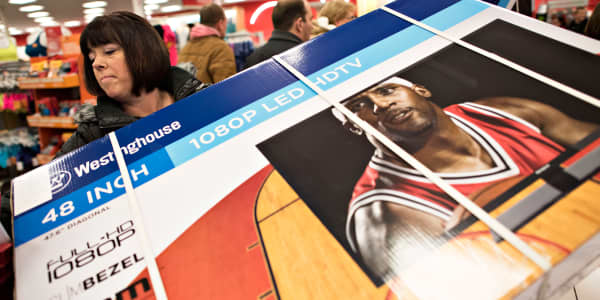This extended bull market run hasn't been kind to active managers. With stock valuations making more managers sit on the sidelines in cash waiting for a big pullback, active managers continue to trail indexes. But active managers may be poised to make a big comeback in 2015.
Noted equity strategist Tom Lee recently told CNBC that 2015 could be huge for active managers, of which only about 1 in 5 outperformed basic benchmarks this year. Lee's confidence in active management is based on historical data that shows that a rising tide lifts all boats in markets like the one we're in now.
The Federal Reserve's just ended quantitative easing, with asset prices near historic highs. Meanwhile, Europe and Japan still seem far from firing on all cylinders—Japan just turned in a horrendous quarter of negative growth, slipping into a recession that took the market by surprise. All of this could lead to less correlation in asset prices. And that's one of the few times when high-quality, low-cost actively managed funds look like a decent bet.
But it's not easy to find the good ones, even among the good ones: A study by Vanguard found that in the three years following a five-star ranking by Morningstar, only 39 percent of five-star funds outperformed. Close to 50 percent of funds with a one star outperformed over the same period.
If there is a real bear market on the way, "[active funds] are not going to do worse than an index, and they might do better," said John Rekenthaler, vice president of research at Morningstar.
But there's no way to tell if we're at the beginning of a bear market: Bear markets are clear only in retrospect.
Read MoreTime to sort sector winners and losers as 2015 nears
If you want to make a bet on active management now based on the belief that asset price correlations will disperse and some stock pickers will finally shine, here are some insights and guidelines used by the experts, institutions and wealthy families to try to find active managers who can outperform the market by 2 percent to 3 percent, net of fees.
The 5 habits of highly effective active managers
1. Follow the flows.
New research from Stanford Graduate School of Business found evidence that many mutual managers were skilled, but highlighted the importance of finding low-fee active managers. Professors Jonathan Berk and Jules H. van Binsbergen, who has since moved to the University of Pennsylvania's Wharton School of Business, looked at a universe of 5,974 mutual funds from 1969 to 2011 and compared the funds' results to comparable Vanguard index funds. They found evidence of skill—outperformers continued outperforming over time. The researchers also found that the skilled managers attracted more assets—and, in fact, very quickly. If you have a pot of money to invest and are seeking an actively managed fund, one basis you could use to pick is the fund flows, if you're on top of the latest data on at least a quarterly basis, said Berk.
2. Look for fees under 1 percent on actively managed U.S. equity funds.
The research also showed that one of the reasons it's been so difficult for experts and investing services to find skilled mutual fund managers is that they charge so much in fees. But at least you know they're out there.
On average, actively managed equity funds charged investors 1.37 percent in expense ratios in 2013, according to the Investment Company Institute. That's down from 1.6 percent in 2000. On an asset-weighted basis, the decline has been even more significant, because investors have been pouring money into the lowest-priced funds.
It is possible to find good money managers charging less than 1 percent. In fact, that's what individual investors should look for, suggested Ram Lee, president at New York City-based Seven Bridges Advisors, which has $3.8 billion in assets and offers CIO services to institutions, individuals and families. A lower fee gives you a much better chance of beating the market and is also a sign that a fund company and a manager are aware of the way the wind is blowing: toward lower-priced funds. Rekenthaler's list of five active funds worth a look (included below) all have expense ratios substantially under 1 percent, except for the American Funds' New World Fund, which comes in right above 1 percent.
3. Understand that it's progressively harder for good managers to deliver good returns.
In his first five years managing Fidelity's Magellan Fund, according to Berk's paper, famous fund manager Peter Lynch had a 2 percent monthly gross alpha on average assets of about $40 million. In his last five years, his outperformance was only 20 basis points per month on assets that ultimately grew to more than $10 billion.
Lynch still had the same level of skill; he just was spreading it thinner. "As the capital flows in, the alpha goes down," said Berk.
As their funds become larger, managers cannot always find the amount of stock they need in all the right companies to build stellar portfolios for all their clients. That leads to the next idea: You need to know how much money the manager is managing.
The prospectus will include the total in the fund in which you're investing. But according to Lee, many managers use the same strategy to invest assets outside the fund. So you'll probably want to email the mutual fund company and ask if the manager is also managing assets for institutions. "Anything above $25 billion is a lot," he said.
4. Don't expect the game to be easy.
Investors such as Lee personally interview managers and hone their analysis and instincts. Lee, for instance, looks for managers who try to beat the market by understanding downside risk and those who have a system for how they pick the companies they invest in. "We focus a lot on repeatability of their process," Lee said. You won't be able to interview managers, but you can look for detailed letters that describe fund holdings and the manager's strategy.
Rekenthaler said it's only in some bear markets that active managers ability to control downside risk has a benefits. "In 2008, active managers did not do better than indexes. But in 2000 to 2002, the market dropped a lot, led by high-priced tech stocks. A lot of active managers that outperformed substantially avoided the one big market sector, technology."
One thing Lee doesn't look at: labels, like growth vs.value. Those labels are determined by a fund's holdings and thus can easily change even within a year.
5. Finally, don't forget the taxes.
Many professional investors look for managers who aim to buy and hold companies for the long term, so take a look at the fund turnover, too. "On taxable portfolios, the tax consequences of a high-turnover approach" could erase any of the returns you've earned above the market, said Jonathan Blau, CEO of Fusion Family Wealth.
5 actively managed funds worth a look
1. Harbor Capital Appreciation
- Type: Large-cap growth
- 10-year annualized return: 9.1 percent
- 10-year +/- S&P: 1.09 percent
- Expense ratio: 0.65
- Total assets: $24.4 billion
- Type: Large-cap blend
- 10-year annualized return: 10.86 percent
- 10-year +/- S&P, annualized: 2.85 percent
- Expense ratio: 0.74
- Total assets: $13.8 billion
- Type: Diversified emerging markets
- 10-year annualized return: 9.95 percent
- 10-year +/- MSCI EAFE, annualized: 4.22 percent
- Expense ratio: 1.06
- Total assets: $24.2 billion
4. PRIMECAP Odyssey Stock POSKX
- Type: Large-cap blend
- Annualized return since inception (11/2004) : 9.8 percent
- Since inception +/- S&P, annualized: 1.8 percent
- Expense ratio: 0.63
- Total assets: $3.5 billion
5. Dodge & Cox Stock DODGX
- Type: Large-cap value
- 10-year annualized return: 7.73 percent
- 10-year +/- S&P, annualized: -.28 percent
- Expense ratio: 0.52
- Total assets: $58.7 billion
(Source: John Rekenthaler, vice president of research at Morningstar)





